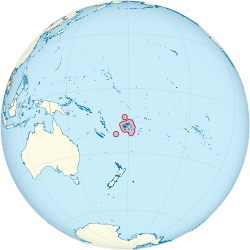Fiji
Republic of Fiji
| |
|---|---|
| Motto: "Rerevaka na Kalou ka Doka na Tui" (Fijian) "Fear God and honour the Queen" | |
| Anthem: God Bless Fiji | |
 | |
| Capital and largest city | Suva[1] 18°10′S 178°27′E / 18.167°S 178.450°E |
| Official languages[2] |
|
| Ethnic groups (2016[3]) |
|
| Religion (2007[4]) |
|
| Demonym(s) | Fijian |
| Government | Unitary parliamentary constitutional republic |
| Naiqama Lalabalavu | |
| Sitiveni Rabuka | |
| Legislature | Parliament |
| Independence | |
• from the United Kingdom | 10 October 1970 |
• Republic | 7 October 1987 |
| Area | |
• Total | 18,274 km2 (7,056 sq mi) (151st) |
• Water (%) | negligible |
| Population | |
• 2021 estimate | 924,610[5][6] (161st) |
• 2017 census | 884,887[7] |
• Density | 46.4/km2 (120.2/sq mi) (148th) |
| GDP (PPP) | 2017 estimate |
• Total | $8.798 billion[8] |
• Per capita | $9,777[8] |
| GDP (nominal) | 2017 estimate |
• Total | $4.869 billion[8] |
• Per capita | $5,411[8] |
| Gini (2013) | 36.4[9] medium |
| HDI (2015) | high · 91st |
| Currency | Fijian dollar (FJD) |
| Time zone | UTC+12 (FJT) |
• Summer (DST) | UTC+13[11] (FJST[12]) |
| Driving side | left |
| Calling code | +679 |
| ISO 3166 code | FJ |
| Internet TLD | .fj |

Fiji is an island country in the Pacific Ocean. It has 322 islands. The most important islands are Vanua Levu and Viti Levu. The capital city and the city with the most people is Suva. There are about 844,330 people in Fiji. The official languages of Fiji are Fijian, English and Hindustani (a mix of Hindi and Urdu). Fiji is part of the Pacific Rim. About 313000 speak Fiji Hindi.
In the 17th and 18th centuries, the Dutch and the British explored Fiji.[13] Fiji was a British colony up until 1970; British occupation lasted almost a century.[14]
Fiji has many forest, mineral, and fish resources.
Divisions and provinces
[change | change source]
Fiji is divided into Four Major Divisions:
These divisions are divided into 14 provinces:
Cities
[change | change source]Incorporated towns
[change | change source]Fijian law defines "towns" as urbanized areas incorporated as municipal bodies, governed by Town Councils.
Unincorporated towns
[change | change source]The following localities are urbanized, but have not been municipally organized.
Tourism
[change | change source]
Fiji has a lot of tourism and many people go to the Nadi and Denarau islands.[15] Most visitors are from Australia, New Zealand and the USA.[16] Fiji has many soft coral reefs. Scuba diving is a common tourist activity.[15] More budget resorts are being opened in remote areas, which provides more tourism opportunities.[15]
Related pages
[change | change source]Other websites
[change | change source]- Pictures of Fiji Archived 2011-08-23 at the Wayback Machine
- UN Fiji LESA - Association Archived 2013-03-08 at the Wayback Machine
References
[change | change source]- ↑ Although Suva is the largest population center that is classified as a "city", the town of Nasinu has a population that is slightly higher than Suva's. See "Age, Sex and Marital Status by Urban and Rural Enumeration, Fiji 2007". statsfiji.gov.fj. Fiji Bureau of Statistics. Archived from the original on 16 October 2017. Retrieved 5 June 2017.
- ↑ "Constitution of the Republic of Fiji". fiji.gov.fj. The Fijian Government. Archived from the original on 11 October 2016. Retrieved 14 March 2017. Subsection 3(3) reads: "This Constitution is to be adopted in the English language and translations in the iTaukei and Hindi languages are to be made available." Subsection 31(3) clarifies that Fiji Hindi is the intended meaning of "Hindi".
- ↑ "Fiji". The World Factbook. CIA. Archived from the original on 7 January 2019. Retrieved 28 December 2014.
- ↑ "Population by Religion and Province of Enumeration". 2007 Census of Population. Fiji Bureau of Statistics. June 2012. Archived from the original on 9 September 2015. Retrieved 7 November 2015. – Percentages are derived from total population figures provided in the source
- ↑ "World Population Prospects 2022". population.un.org. United Nations Department of Economic and Social Affairs, Population Division. Retrieved July 17, 2022.
- ↑ "World Population Prospects 2022: Demographic indicators by region, subregion and country, annually for 1950-2100" (XSLX). population.un.org ("Total Population, as of 1 July (thousands)"). United Nations Department of Economic and Social Affairs, Population Division. Retrieved July 17, 2022.
- ↑ Fiji Bureau of Statistics (5 January 2018). "2017 Population and Housing Census – Release 1". Census 2017. Archived from the original on 12 February 2018. Retrieved 8 April 2018.
- ↑ 8.0 8.1 8.2 8.3 "Fiji". International Monetary Fund.
- ↑ "Gini Index". World Bank. Retrieved 5 November 2017.
- ↑ "2016 Human Development Report" (PDF). United Nations Development Programme. 2016. Retrieved 5 November 2017.
- ↑ "Fiji Reignites Daylight Saving Time on November 29". timeanddate.com. 10 November 2009. Retrieved 2 May 2010.
- ↑ "FJST – Fiji Summer Time". timeanddate.com. Retrieved 24 October 2012.
- ↑ "Fiji: History". infoplease.com. 2005. Retrieved 2010-09-15.
- ↑ "Tourism Fiji : A Social, Political and Environmental Case Study" (PDF). tamu.edu. 2007. Archived from the original (PDF) on 2010-07-12. Retrieved 2010-09-15.
- ↑ 15.0 15.1 15.2 Fiji Travel Information and Travel Guide. Lonely Planet. Retrieved April 2010. Archived 1999-02-24 at the Wayback Machine
- ↑ "Arrivals information Archived 2007-01-06 at the Wayback Machine" Bureau of Statistics.


